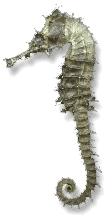
Seahorses Join Tigers, Rhinos on Endangered List
by Jim Lobe
 |
by Jim Lobe |
|
 (IPS) WASHINGTON--
On
the eve of a major international conference on preserving the world's biodiversity, the World Wildlife Fund (WWF) released a list of 10 species that are in urgent need of global protection.
(IPS) WASHINGTON--
On
the eve of a major international conference on preserving the world's biodiversity, the World Wildlife Fund (WWF) released a list of 10 species that are in urgent need of global protection.
The Patagonian toothfish and seahorses, for which demand has mushroomed in recent years, have joined tigers and Sumatran rhinos -- perennials on WWF's "most-wanted" list for the past decade -- as increasingly endangered by international commerce. The list, which also includes hawksbill turtles, yellow-headed parrots and Asian elephants, is being submitted to delegates who will gather in Santiago, Chile, Nov. 3-15 for the biennial meeting of the Convention on International Trade in Endangered Species (CITES), the only global treaty that regulates trade in threatened and endangered animals and plants. "Consumer demand clearly exceeds supply for a number of highly threatened species," said Ginette Hemley, vice president of species conservation at the Geneva-based WWF. "Despite much progress, illegal wildlife trade is still worth billions of dollars a year, with profit margins comparable to the drug trade." CITES, which has been signed by 160 countries, maintains three of its own lists, or appendices, of endangered plants and animals for which member governments are supposed to provide varying degrees of protection. Appendix I is for plants and animals or animal parts that are banned from international commerce. Appendix II includes those plants and animals that can be traded but under regulations to ensure that the species can be sustained. Appendix III is for plants and animals that can be freely traded but whose sustainability is a concern to one or more members. CITES is best known for helping to reduce poaching of African elephants by banning ivory sales in 1989 when they were listed in Appendix I. Five years ago, CITES gave permission to Namibia, Zimbabwe and Botswana, which have large elephant herds, to sell 60 tonnes of ivory to Japan. The money earned was used for elephant conservation. A South African-led proposal to further relax the CITES ban to permit annual sales is expected to be a major point of controversy at the meeting. Four of the 10 species listed by WWF this year are already in Appendix I. They include tigers, hawksbill sea turtles, Sumatran rhinos, and Asian elephants. The number of tigers in the wild has been reduced by roughly 95 percent over the past century, leaving fewer than 5,000 of the animals, says WWF. Tigers have succumbed both to a loss of habitat and to strong demand, particularly in Asia, for tiger parts that are used in traditional Chinese medicines. Hawksbill sea turtles, whose distinctive "tortoiseshell" shells are used for curios and jewellery, have been endangered by a large volume of illegal trade both in their shells and in their meat. Like other rhinos, the Sumatran rhino, which is the most threatened of three species of Asian rhinos, has seen its ranks reduced to at most 300 in Indonesia and Malaysia by a combination of habitat loss and unrelenting poaching for rhino horn, which is also used in traditional Chinese medicine. Like their African cousins, Asian elephants in the wild have been reduced to between 35,000 and 50,000 due to habitat loss and an increase in poaching for ivory, according to WWF. WWF wants yellow-headed Amazon parrots upgraded from Appendix II to Appendix I at the CITES meeting. It said the capture of these birds for the pet market, combined with severe habitat loss, has caused the wild population to plummet more than 90 percent since 1970, leaving fewer than 10,000 birds in Mexico and a few hundred in Guatemala and Belize. WWF will also lobby for big-leaf mahogany to be moved from Appendix III to Appendix II. A keystone species for Amazon rainforests, the tree is highly prized above all in the United States, which is the world's leading mahogany importer. The administration of President George W. Bush is yet to decide whether it will support increasing protection of mahogany. WWF wants the remaining four species on its list, none of which has been listed by CITES, to receive Appendix II protection. They include the Patagonian toothfish which, marketed under the more appealing name of "Chilean sea bass," has become extremely popular among seafood lovers in the United States and Japan. Toothfish populations, according to WWF, are now on the verge of collapse throughout the southern hemisphere, where they are caught not only by licensed fishermen but by pirate boats as well. WWF also believes seahorses should be subject to Appendix II protections. Of 32 known species of seahorses, at least 20 are threatened by unregulated trade of both live seahorses for aquariums and trade in dried seahorses, which are sold as curios and for traditional Chinese medicines. Whale sharks, the world's largest fish, have been over-fished for their meat, fins, liver, cartilage, and skin, according to WWF. Already, the United States, Maldives, Taiwan, Honduras, Australia and the Philippines have banned hunting whale sharks in their territorial waters. The Malayan giant turtle, which is found in Malaysia and Indonesia, is also endangered as a result of demand in Asia for its meat, and, to a lesser extent, as pets.
Albion Monitor
October 24 2002 (http://albionmonitor.net) All Rights Reserved. Contact rights@monitor.net for permission to use in any format. |